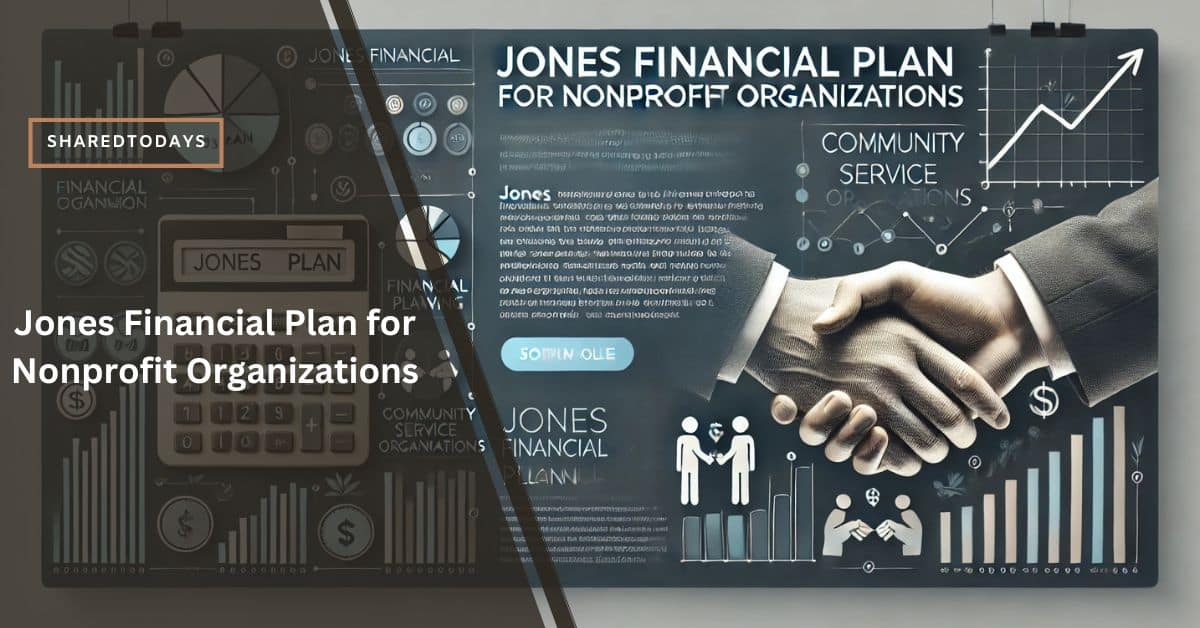Jones Financial Plan For Nonprofit Organizations – Essential Steps!
Using the Jones Financial Plan for my nonprofit made managing money so much easier. It helped me stay organized and build trust with our donors.
The Jones Financial Plan for Nonprofit Organizations helps nonprofits manage their money better. It focuses on budgeting, raising funds from different sources, and being clear with donors. This plan helps keep the nonprofit financially stable.
Stay tuned with us as we explore the Jones Financial Plan for Nonprofit Organizations! We’ll share how it can help your nonprofit stay financially strong. Don’t miss it!
Overview of the Jones Financial Plan
The Jones Financial Plan is a special financial strategy for nonprofits. It helps create a stable financial framework that supports the organization’s mission. Unlike other financial plans, this one is tailored to address the unique challenges nonprofits face, such as unpredictable funding.
Key features of the plan include:
- Financial Assessment: Reviewing finances to find areas for improvement.
- Strategic Budgeting: Creating budgets that align with the organization’s goals.
- Revenue Diversification: Finding new ways to raise money to reduce reliance on a single source.
Importance for Nonprofit Organizations
Nonprofits face unique financial challenges that can affect their ability to deliver programs and services. The Jones Financial Plan helps organizations manage these challenges by providing a structured approach to financial management. It ensures resources are used effectively to maximize impact while maintaining stakeholder trust.
The plan is important because it helps nonprofits achieve financial stability, build stakeholder confidence, and align financial decisions with their mission.
How It Differs From Conventional Financial Strategies?
Traditional financial strategies often focus on short-term gains and may not align with the mission-driven nature of nonprofits. The Jones Financial Plan focuses on long-term sustainability and mission alignment, ensuring financial decisions support the organization’s goals.
The main differences are:
- Long-Term Focus: Emphasis on long-term financial health rather than short-term gains.
- Mission Alignment: Financial decisions align with the organization’s mission.
- Transparency: Clear financial reporting builds trust with stakeholders.
Understanding the Financial Challenges of Nonprofit Organizations
Nonprofits operate with significant financial constraints. They often rely on external funding, which can be unpredictable. This unpredictability makes it crucial for nonprofits to have a robust financial plan.
Unique Financial Constraints in Nonprofits
Nonprofits face several unique challenges:
- Unpredictable Funding: Relying on donations, grants, and fundraising events, which can be unpredictable.
- Limited Resources: Managing limited funds while maintaining efficiency.
- Regulatory Compliance: Following specific financial regulations.
Impact of Unpredictable Revenue Streams
Unpredictable funding can lead to financial instability, making it hard for nonprofits to plan and budget effectively. This can impact program delivery and long-term sustainability.
Case Study: Common Financial Pitfalls in Nonprofits
Many nonprofits struggle with financial management due to over-reliance on a single funding source, poor budgeting, and inadequate financial reporting. These issues can lead to financial instability and undermine the organization’s mission.
Read More: stanley 85-905 7/16 wrench
What is the Jones Financial Plan?
The Jones Financial Plan is a comprehensive financial strategy for nonprofits. It emphasizes transparency, sustainability, and mission alignment. The plan is built around these core principles:
- Transparency: Clear financial reporting and accountability.
- Sustainability: Focus on long-term financial stability.
- Mission Alignment: Financial decisions support the organization’s mission.
Origin and Development of the Jones Financial Plan
The Jones Financial Plan was developed to address the unique financial challenges nonprofits face. It combines best practices in financial management with an understanding of nonprofit operations.
Core Principles: Transparency, Sustainability, and Mission Alignment
The plan focuses on three core principles:
- Transparency: Ensuring clear financial reporting and accountability.
- Sustainability: Focusing on long-term financial stability.
- Mission Alignment: Ensuring financial decisions support the organization’s mission.
Who Can Benefit Most from This Plan?
All nonprofits can benefit from the Jones Financial Plan, especially those seeking to improve financial stability and stakeholder confidence.
What are the Key Components of the Jones Financial Plan?
The Jones Financial Plan is designed to help nonprofits manage their finances effectively. It includes several important components that work together to ensure financial stability and sustainability.
1. Financial Assessment and Audit
This involves reviewing your nonprofit’s finances to see where you can improve. It’s like getting a check-up for your financial health. Regular audits help ensure you’re following the rules and identify areas where you can do better.
2. Strategic Budgeting
Creating a budget that aligns with your mission is crucial. This means making sure every dollar you spend supports your goals. It’s about prioritizing what matters most to your organization.
3. Revenue Diversification
Don’t put all your eggs in one basket. Instead, find different ways to raise money. This could be through partnerships with businesses, crowdfunding, or even starting a small business to support your nonprofit.
4. Advanced Cash Flow Management
Make sure you have enough money coming in to cover your expenses. This involves keeping some cash aside for emergencies and planning ahead to avoid financial surprises.
5. Risk Assessment and Mitigation
Think about what could go wrong and have a plan to deal with it. This helps you prepare for unexpected financial challenges and ensures your nonprofit stays strong.
6. Strategic Investment
Invest in things that will help your nonprofit in the long run. This could be investing in assets that generate income or in programs that support your mission.
7. Regulatory Compliance
Follow the rules. This means keeping track of financial regulations and making sure you comply with them. It helps build trust with donors and stakeholders.
8. Financial Technology and Automation
Use technology to make financial tasks easier and more efficient. This could be using online accounting tools or automating payments to save time and reduce errors.
9. Integration with Donor Relationship Management Tools
Use tools that help you manage donor relationships better. This means tracking interactions with donors, managing donations, and communicating with them in a personalized way.
10. Metrics for Measuring Financial Health and Impact
Use numbers to see how well your nonprofit is doing financially and how much impact you’re having. This helps you make informed decisions and show stakeholders that you’re making a difference.
Read: the power of visualization: enhancing your meditation practice smartfityoga
What Are the Key Benefits of the Jones Financial Plan for Nonprofit Organizations?

Implementing the plan offers several benefits for nonprofits.
Improved Financial Stability
The plan helps nonprofits achieve financial stability through diversified funding and effective cash management.
Enhanced Stakeholder Confidence Through Transparency
Clear financial reporting builds trust with stakeholders, including donors and grantors.
Optimized Resource Allocation and Impact Maximization
By aligning financial decisions with the organization’s mission, nonprofits can maximize their impact.
Real-Life Success Stories of Nonprofits Implementing the Plan
Several nonprofits have successfully implemented the Jones Financial Plan, achieving improved financial stability and increased stakeholder confidence.
What steps are involved in implementing the Jones Financial Plan?
Step-by-Step Guide to Assessing and Adopting the Plan
- Financial Assessment: Conduct a thorough financial review.
- Develop a Strategic Budget: Create a mission-centric budget.
- Implement Revenue Diversification: Explore new funding sources.
Training and Skill Development for Team Members
Providing training on financial management helps team members implement the plan effectively.
Engaging Stakeholders and Building Consensus
Engaging stakeholders in the planning process ensures everyone is aligned with the organization’s financial goals.
Monitoring, Evaluating, and Adapting the Plan Over Time
Regularly reviewing and adjusting the plan helps nonprofits respond to changing financial conditions.
Read Also: hg556a v100r001c08b018 password
Advanced Insights Beyond Conventional Practices
The Jones Financial Plan offers advanced financial strategies that help nonprofits go beyond traditional methods. These insights help nonprofits use technology, data, and partnerships to improve their financial management and sustainability.
Leveraging Data Analytics for Predictive Financial Modeling
Using data analytics helps nonprofits predict financial trends and make informed decisions. This involves looking at past financial data to forecast future performance. By using data analytics, nonprofits can:
- Prepare for Financial Challenges: Identify potential risks and plan ahead.
- Use Resources Wisely: Allocate funds to programs that have the most impact.
- Engage Stakeholders: Share clear financial insights with donors and supporters.
Exploring Collaborative Funding Opportunities
Working with other organizations can lead to new funding opportunities. This includes partnering with other nonprofits, businesses, or government agencies. Collaborative funding can:
- Diversify Income: Reduce reliance on a single funding source by working together on fundraising.
- Improve Program Impact: Combine resources to deliver more effective programs.
- Build Strong Partnerships: Create lasting relationships that support long-term goals.
Creating an Endowment: A Long-Term Stability Strategy
Setting up an endowment provides a stable source of funding for the long term. An endowment is a fund that generates income through investments, providing a predictable revenue stream. This strategy helps nonprofits:
- Ensure Financial Stability: Secure a steady income source for ongoing operations.
- Support Important Initiatives: Use endowment funds to invest in strategic programs.
- Build a Legacy: Create a lasting financial foundation that supports the organization’s mission.
Tax Optimization Strategies for Nonprofits
Optimizing tax strategies helps nonprofits keep more resources. This involves understanding and using tax laws that apply to nonprofits. Effective tax planning can:
- Reduce Tax Obligations: Ensure compliance while minimizing taxes.
- Maximize Tax Benefits: Take advantage of tax deductions and credits available to nonprofits.
- Improve Financial Efficiency: Use tax savings to support programs and mission-driven activities.
Comparative Analysis: Why the Jones Financial Plan Outperforms Other Strategies
The Jones Financial Plan offers several advantages over traditional financial models, including its focus on mission alignment and long-term sustainability.
Key Differences from Traditional Financial Models
- Mission Alignment: Financial decisions align with the organization’s mission.
- Long-Term Focus: Emphasis on long-term financial health.
- Transparency: Enhanced financial reporting builds stakeholder trust.
Specific Advantages Over Competitor Plans
- Transparency: Clear financial reporting ensures accountability.
- Sustainability: Focus on long-term financial stability.
Testimonials from Financial Experts and Nonprofit Leaders
Many experts and nonprofit leaders have praised the Jones Financial Plan for its effectiveness in improving financial stability and stakeholder confidence.
Practical Tools and Resources for Nonprofits
Several tools and resources are available to support nonprofits in implementing the Jones Financial Plan.
Budget Templates and Financial Tracking Tools
Using budget templates and financial tracking tools can simplify financial management.
Recommended Financial Software for Nonprofits
Selecting the right financial software can streamline financial processes and improve efficiency.
Accessing Workshops and Certification Programs
Participating in workshops and certification programs helps nonprofits develop the skills needed to implement the plan effectively.
Common Mistakes to Avoid While Implementing the Jones Financial Plan

When implementing the Jones Financial Plan, nonprofits should be aware of common mistakes that can hinder success. These mistakes can lead to financial instability, undermine stakeholder trust, and impact the organization’s ability to achieve its mission. Here are some key errors to avoid:
1. Over-Reliance on a Single Revenue Stream
Don’t rely too much on one source of funding. If that source dries up, it can cause financial problems. Instead, try to get money from different places, like grants, donations, and partnerships. Diversifying your revenue streams helps ensure financial stability and reduces the risk of financial shocks.
For example, if a nonprofit relies heavily on government grants and those grants are reduced, it could face significant financial challenges. By diversifying revenue streams, nonprofits can mitigate this risk and maintain financial stability.
2. Neglecting Regular Financial Audits
Regularly check your finances to ensure everything is in order. This helps you follow the rules and find areas for improvement. It’s like getting a financial check-up to stay healthy. Regular audits also help build trust with stakeholders by demonstrating transparency and accountability.
Neglecting audits can lead to financial mismanagement and compliance issues, which can damage the organization’s reputation and lead to legal problems.
3. Failing to Engage Key Stakeholders in Planning
Involve important people, like board members and donors, in your financial planning. They need to be on board with your plan for it to work well. Stakeholder engagement helps ensure that everyone is aligned with the organization’s financial goals and strategies.
Engaging stakeholders also fosters a sense of ownership and commitment, which is crucial for successful implementation of the financial plan.
4. Inadequate Training and Capacity Building
Make sure your team knows how to manage finances effectively. Without proper training, you might struggle to implement the plan correctly. Training should cover financial analysis, budgeting, and risk management.
Investing in staff training helps ensure that financial decisions are informed and strategic, aligning with the organization’s mission and goals.
5. Insufficient Risk Management
Think about what could go wrong and have a plan to deal with it. This helps you stay safe from unexpected financial problems. Risk management involves identifying potential risks, assessing their impact, and developing strategies to mitigate them.
For instance, maintaining cash reserves and diversifying revenue streams are strategies that can help mitigate financial risks.
6. Lack of Ongoing Evaluation and Adjustment
Regularly review your financial plan to make sure it’s working well. If things change, adjust your plan to keep it on track. This involves monitoring financial performance, evaluating the effectiveness of the plan, and making necessary adjustments.
Ongoing evaluation helps nonprofits respond to changing financial conditions and ensure that their financial strategies remain aligned with their mission and goals.
By avoiding these common mistakes, nonprofits can successfully implement the Jones Financial Plan and achieve better financial stability, stakeholder confidence, and mission alignment.
Future Trends in Nonprofit Financial Planning
Nonprofit financial planning is evolving with key trends ensuring long-term sustainability:
- Diversified Revenue Streams:
Nonprofits are exploring small businesses and services to reduce reliance on donations and enhance financial resilience.
- Transparency:
Sharing detailed financial data builds trust and strengthens donor relationships by showcasing accountability.
- Technology Adoption:
Financial software streamlines processes, improves accuracy, and allows nonprofits to focus on strategic priorities.
- Flexible Planning:
Adaptive budgets help nonprofits respond to changes and prepare for unexpected challenges.
- Sustainability Focus:
Aligning financial strategies with environmental and social goals meets donor expectations, reduces costs, and boosts reputations.
- Data Analysis:
Leveraging data improves forecasting, strategic decision-making, and financial stability.
- Corporate Partnerships:
Collaborations with businesses bring resources, expertise, and networks, amplifying nonprofit impact.
FAQs:
1. What is the Jones Financial Plan for Nonprofit Organizations?
The Jones Financial Plan is a special way to help nonprofits manage their money. It focuses on being transparent, sustainable, and aligning with the organization’s mission.
2. What are the core principles of the Jones Financial Plan?
The plan is based on three main ideas: transparency, sustainability, and mission alignment. These principles ensure that financial decisions support the nonprofit’s goals.
3. What are some key parts of the Jones Financial Plan?
Key parts include budgeting, managing cash flow, assessing risks, and making strategic investments. These help nonprofits make smart financial decisions and ensure they can keep going long-term.
4. How does the Jones Financial Plan help with getting different types of funding?
The plan encourages nonprofits to find multiple ways to raise money, like grants, donations, and fees for services. This helps them not rely too much on one source of funding.
5. What role does technology play in the Jones Financial Plan?
Technology helps make financial tasks easier, more accurate, and faster. Nonprofits can use digital tools for budgeting, reporting, and forecasting.
6. How does the Jones Financial Plan promote transparency and accountability?
The plan emphasizes clear financial reporting and regular audits to ensure transparency and accountability. This builds trust with stakeholders and shows responsible financial management.
7. Why is risk management important in the Jones Financial Plan?
A: Risk management involves identifying potential financial risks and taking steps to mitigate them. This helps nonprofits prepare for unexpected challenges and stay stable.
8. How does the Jones Financial Plan support long-term growth and sustainability?
The plan encourages nonprofits to think about long-term growth by building funds for the future, expanding programs, and finding new ways to raise money. This ensures nonprofits can keep doing their mission-driven work over time.
9. Are there specific services or consultants that specialize in nonprofit financial planning?
Yes, there are firms that specialize in helping nonprofits with financial planning, compliance, and strategic planning.
10. How can nonprofits ensure they follow financial rules?
Nonprofits can work with specialized accounting firms to ensure they comply with regulations like filing tax forms correctly.
11. What role do financial advisors play in supporting nonprofits?
A: Financial advisors can provide guidance on managing assets, investments, and risks to help nonprofits achieve financial stability and support their mission.
12. How can donors make sure their contributions are tax-deductible?
Donors should check if the nonprofit is qualified by looking it up on the IRS website or asking a financial advisor for advice.
13. What are some alternative ways to support nonprofits if you can’t give money?
You can support nonprofits by donating your time, goods, or services, which can be just as valuable as money.
Conclusion:
The Jones Financial Plan offers a comprehensive approach to financial management for nonprofits, focusing on transparency, sustainability, and mission alignment. By implementing this plan, nonprofits can achieve improved financial stability, enhance stakeholder confidence, and maximize their impact.
Consider adopting the Jones Financial Plan today to strengthen your nonprofit’s financial foundation and ensure long-term success.
Read Related:







